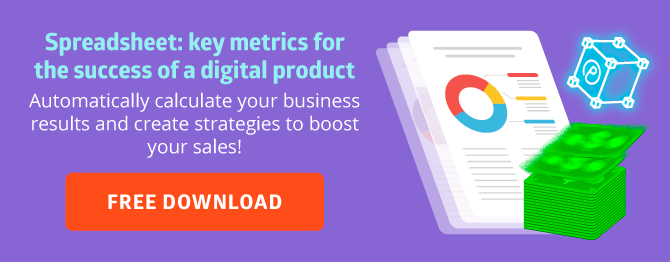
Digital Product Lifecycle: Stages and Strategies
Understand the stages a digital product goes through during its lifespan and how to avoid its saturation.

As consumers, we buy hundreds of products every year. Products also have a lifecycle just like us.
Over time, a longstanding item can become less popular, something that may be due to a demand for more modern products, specially just after their launch.
When it comes to the digital world, what is the digital product lifecycle? The internet has its particularities, as well as products linked directly to it.
So, check below what the lifecycle of this type of product is, and the main tips to extend it!
After all, what is a digital product lifecycle?
The digital product lifecycle is defined by the phases through which it undergoes from its launch to its decline — something that also depends a lot on the market.
This cycle can be divided into stages according to the sales volume for the period. In total, there are four stages, each one with its own characteristics:
Introduction
The introduction phase of a digital product lifecycle is considered to be decisive for the business. It has a high cost, considering that it encompasses the launch of the product, expenses with research, testing with consumers and marketing to promote it, in addition to the development of prototypes.
In this phase, the market is usually small for the product and sales are still low, albeit increasing.
It is also in this stage that customer attraction takes place; therefore, the strategies need to be well defined. Thus, it’s important to invest in channels for consumer relationship, such as social media, or also, in digital influencers, depending on the type of product you wish to launch.
VIDEO: How to launch a digital product with Erico Rocha
Growth
This stage is marked by strong sales growth and also profitability. The business can start to benefit from the savings in production scale, obtaining an increase in profit margins.
Consequently, entrepreneurs have the possibility of investing more money in promoting the product in order to maximize the growth potential.
In order to ensure success in this phase of a digital product lifecycle, it’s necessary to adopt a few strategies, such as marketing consolidation, logistics optimization and also, customer loyalty.
View this post on Instagram
Maturity
The maturity stage of a digital product lifecycle is characterized by establishing the product. The entrepreneur’s goal is to maintain the position in the market, achieved during the growth phase.
It is necessary to pay attention, because the period is of high competitiveness, and investments need to be made wisely.
It’s worth remembering that, in this phase, it’s necessary to consider possible modifications to the product.
After all, nowadays we deal with constant changes and innovations that appear all the time, which can make the product obsolete quickly if it isn’t well planned and adapted. Once again, this is a strategy that ensures a competitive edge.
Decline
Eventually, a product’s market begins to shrink — we call this a decline. In this step of the digital product lifecycle, a digital product needs to undergo constant changes, because consumer aspirations vary rapidly, which requires flexibility.
Investments in promotional campaigns is one of the best strategies, along with actions focused on the price of the product.
It’s worth pointing out that this isn’t always a negative thing, considering that the product might have seasonal sales and receive something complementary to it, thus creating a new cycle.
Imagine a course on digital marketing. If it becomes obsolete and declines, a version 2.0 can be created.
Digital product lifecycle: How does it work?
Knowing the lifecycle of a digital product and understanding its particularities is important due to its differences in comparison to traditional products.
The digital transformation has demanded more from entrepreneurs — especially from those who invest in production for digital media.
The introduction of digital products, for example, can benefit from a few tools, such as anticipating the launch of a product on the market.
In addition, it is assumed that the use of digital marketing actions helps make the product be recognized in a short period of time.
Therefore, in this phase, it’s necessary to have the business’ buyer persona mapping at hand. This documentation will help you understand your audience’s real need, thus helping in greater precision of strategic actions, such as boosting the product’s territorial coverage.
VIDEO: How to create a buyer persona for your business | Hotmart Tips
In the growth and maturity phases, an important point is the use of metrics. Using the correct indicators will help you when the time comes to deliver and make your product and brand evolve.
In the case of digital products, a few metrics have great relevance, such as:
- Cost of acquisition per customer;
- Churn rate;
- Average ticket;
- Lifetime value;
- Contribution margin.
Automatically calculate your business results:

By means of these indicators, it is possible to identify points of failure in the performance and alignment of the product in relation to customers’ demands, so that the correct changes — as for example, content updating—, can be achieved.
Eventually, a decline will occur, especially regarding a digital product lifecycle. However, if you don’t want this to happen, it’s important to read the tips on the topic below.
What you should do to keep your digital products updated
As important as knowing the digital product lifecycle, is understanding what you should do to keep it always updated.
In the previous topic, we underscored how this would work. Now, we’ll go into more detail regarding the issue.
Have good brand positioning
Even if you’re an individual producer, it is important to have strong brand positioning. This will give you a competitive edge and help you create products that are better aligned with what your audience expects from your brand.
To do so, it’s necessary to work on your marketing strategies, try to maintain a close relationship with consumers and have a discourse that gives continuity to values previously established.
View this post on Instagram
Increase a few phases of the digital product lifecycle
From the moment that your CVP is well planned, the chances of strengthening the item being offered increases, which allows the extension of a few stages in this cycle, such as growth. Therefore, marketing strategies are crucial in attracting and retaining consumers.
Try to create ways of promoting your product in order to keep it growing. Whenever you launch a new version of an online course, for example, contact your customers who have already purchased the previous version.
VIDEO: How to Launch an Online Course | Hotmart Tips
Update according to the market
You need to pay attention to the market and the changes and innovations that emerge.
For example: a digital marketing course needs to be constantly updated due to the insertion of new technologies in the segment, and to the appearance or strengthening of certain channels.
By the way, speaking of updating, observe which formats your audience prefers (video, eBooks, live streams, etc.) and bring more interactivity to your past content.
This way, your students will be able to learn in a dynamic manner and also absorb better what is being taught, something that reflects the quality of the product.
Invest in constant updating
As you can see, regarding digital product lifecycle, saturation is a fact, but you can prevent it by paying attention and being cautious.
Therefore, knowing and monitoring your product’s lifecycle will make it easier to identify when you should focus on updating and what should be done in each case.






